[English] 日本語
 Yorodumi
Yorodumi- PDB-4bwb: Structure of Evolved Agonist-bound Neurotensin Receptor 1 Mutant ... -
+ Open data
Open data
- Basic information
Basic information
| Entry | Database: PDB / ID: 4bwb | ||||||
|---|---|---|---|---|---|---|---|
| Title | Structure of Evolved Agonist-bound Neurotensin Receptor 1 Mutant without Lysozyme Fusion | ||||||
 Components Components |
| ||||||
 Keywords Keywords | SIGNALING PROTEIN / G PROTEIN COUPLED RECEPTOR / MEMBRANE PROTEIN | ||||||
| Function / homology |  Function and homology information Function and homology informationregulation of locomotion involved in locomotory behavior / Peptide ligand-binding receptors / positive regulation of locomotion / neuropeptide receptor binding / G protein-coupled neurotensin receptor activity / regulation of inositol trisphosphate biosynthetic process / inositol phosphate catabolic process / symmetric synapse / positive regulation of gamma-aminobutyric acid secretion / D-aspartate import across plasma membrane ...regulation of locomotion involved in locomotory behavior / Peptide ligand-binding receptors / positive regulation of locomotion / neuropeptide receptor binding / G protein-coupled neurotensin receptor activity / regulation of inositol trisphosphate biosynthetic process / inositol phosphate catabolic process / symmetric synapse / positive regulation of gamma-aminobutyric acid secretion / D-aspartate import across plasma membrane / regulation of membrane depolarization / positive regulation of arachidonate secretion / vocalization behavior / response to antipsychotic drug / neuron spine / L-glutamate import across plasma membrane / regulation of behavioral fear response / regulation of respiratory gaseous exchange / neuropeptide hormone activity / cAMP biosynthetic process / positive regulation of inhibitory postsynaptic potential / negative regulation of systemic arterial blood pressure / negative regulation of release of sequestered calcium ion into cytosol / digestive tract development / positive regulation of glutamate secretion / G alpha (q) signalling events / hyperosmotic response / response to mineralocorticoid / response to food / positive regulation of inositol phosphate biosynthetic process / response to lipid / response to corticosterone / cellular response to lithium ion / temperature homeostasis / response to stress / detection of temperature stimulus involved in sensory perception of pain / associative learning / conditioned place preference / neuropeptide signaling pathway / cellular response to dexamethasone stimulus / response to axon injury / transport vesicle / axon terminus / positive regulation of release of sequestered calcium ion into cytosol / blood vessel diameter maintenance / response to amphetamine / adult locomotory behavior / dendritic shaft / learning / response to cocaine / liver development / cellular response to nerve growth factor stimulus / visual learning / cytoplasmic side of plasma membrane / terminal bouton / response to estradiol / perikaryon / dendritic spine / positive regulation of phosphatidylinositol 3-kinase/protein kinase B signal transduction / positive regulation of apoptotic process / membrane raft / receptor ligand activity / axon / negative regulation of gene expression / neuronal cell body / dendrite / positive regulation of gene expression / negative regulation of apoptotic process / protein-containing complex binding / cell surface / extracellular region / identical protein binding / plasma membrane Similarity search - Function | ||||||
| Biological species |  | ||||||
| Method |  X-RAY DIFFRACTION / X-RAY DIFFRACTION /  SYNCHROTRON / SYNCHROTRON /  MOLECULAR REPLACEMENT / Resolution: 3.57 Å MOLECULAR REPLACEMENT / Resolution: 3.57 Å | ||||||
 Authors Authors | Egloff, P. / Hillenbrand, M. / Scott, D.J. / Schlinkmann, K.M. / Heine, P. / Balada, S. / Batyuk, A. / Mittl, P. / Plueckthun, A. | ||||||
 Citation Citation |  Journal: Proc.Natl.Acad.Sci.USA / Year: 2014 Journal: Proc.Natl.Acad.Sci.USA / Year: 2014Title: Structure of Signaling-Competent Neurotensin Receptor 1 Obtained by Directed Evolution in Escherichia Coli Authors: Egloff, P. / Hillenbrand, M. / Klenk, C. / Batyuk, A. / Heine, P. / Balada, S. / Schlinkmann, K.M. / Scott, D.J. / Schuetz, M. / Plueckthun, A. | ||||||
| History |
|
- Structure visualization
Structure visualization
| Structure viewer | Molecule:  Molmil Molmil Jmol/JSmol Jmol/JSmol |
|---|
- Downloads & links
Downloads & links
- Download
Download
| PDBx/mmCIF format |  4bwb.cif.gz 4bwb.cif.gz | 132.5 KB | Display |  PDBx/mmCIF format PDBx/mmCIF format |
|---|---|---|---|---|
| PDB format |  pdb4bwb.ent.gz pdb4bwb.ent.gz | 104.1 KB | Display |  PDB format PDB format |
| PDBx/mmJSON format |  4bwb.json.gz 4bwb.json.gz | Tree view |  PDBx/mmJSON format PDBx/mmJSON format | |
| Others |  Other downloads Other downloads |
-Validation report
| Summary document |  4bwb_validation.pdf.gz 4bwb_validation.pdf.gz | 462.4 KB | Display |  wwPDB validaton report wwPDB validaton report |
|---|---|---|---|---|
| Full document |  4bwb_full_validation.pdf.gz 4bwb_full_validation.pdf.gz | 468.8 KB | Display | |
| Data in XML |  4bwb_validation.xml.gz 4bwb_validation.xml.gz | 22.2 KB | Display | |
| Data in CIF |  4bwb_validation.cif.gz 4bwb_validation.cif.gz | 29.5 KB | Display | |
| Arichive directory |  https://data.pdbj.org/pub/pdb/validation_reports/bw/4bwb https://data.pdbj.org/pub/pdb/validation_reports/bw/4bwb ftp://data.pdbj.org/pub/pdb/validation_reports/bw/4bwb ftp://data.pdbj.org/pub/pdb/validation_reports/bw/4bwb | HTTPS FTP |
-Related structure data
| Related structure data |  3zevC  4buoSC  4bv0C C: citing same article ( S: Starting model for refinement |
|---|---|
| Similar structure data |
- Links
Links
- Assembly
Assembly
| Deposited unit | 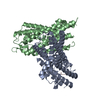
| ||||||||
|---|---|---|---|---|---|---|---|---|---|
| 1 | 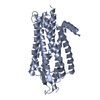
| ||||||||
| 2 | 
| ||||||||
| Unit cell |
| ||||||||
| Noncrystallographic symmetry (NCS) | NCS oper: (Code: given Matrix: (-0.4579, 0.1531, -0.875), Vector: |
- Components
Components
| #1: Protein | Mass: 37598.082 Da / Num. of mol.: 2 / Fragment: RESIDUES 50-390 / Mutation: YES Source method: isolated from a genetically manipulated source Source: (gene. exp.)   #2: Protein/peptide | Mass: 1087.277 Da / Num. of mol.: 2 / Fragment: C-TERMINUS, RESIDUES 157-162 Source method: isolated from a genetically manipulated source Source: (gene. exp.)   Has protein modification | Y | Sequence details | CHAIN A, B HAS MUTATION AT FOLLOWING POSITIONS S83G,A86L, ...CHAIN A, B HAS MUTATION AT FOLLOWING POSITIONS S83G,A86L, S101R,H103D,H105Y,L119F,M121L,E124D,R143K,D150E,A161V, R167L,R213L,V234L,K235R,V240L,I253A,I260A,N262R, K263R,H305R,C332V,F342A,T354S,F358V,S362A.FURTHERMOR | |
|---|
-Experimental details
-Experiment
| Experiment | Method:  X-RAY DIFFRACTION / Number of used crystals: 1 X-RAY DIFFRACTION / Number of used crystals: 1 |
|---|
- Sample preparation
Sample preparation
| Crystal | Density Matthews: 3.88 Å3/Da / Density % sol: 68.34 % / Description: NONE |
|---|---|
| Crystal grow | pH: 5.5 Details: 20% (V/V) PEG600, 0.2 M CACL2, 50 MM NAACETATE PH 5.5 |
-Data collection
| Diffraction | Mean temperature: 100 K |
|---|---|
| Diffraction source | Source:  SYNCHROTRON / Site: SYNCHROTRON / Site:  SLS SLS  / Beamline: X06SA / Wavelength: 1 / Beamline: X06SA / Wavelength: 1 |
| Detector | Type: DECTRIS PILATUS 6M / Detector: PIXEL |
| Radiation | Protocol: SINGLE WAVELENGTH / Monochromatic (M) / Laue (L): M / Scattering type: x-ray |
| Radiation wavelength | Wavelength: 1 Å / Relative weight: 1 |
| Reflection | Resolution: 3.56→50 Å / Num. obs: 14522 / % possible obs: 99.7 % / Redundancy: 7.2 % / Biso Wilson estimate: 174.88 Å2 / Rmerge(I) obs: 0.11 / Net I/σ(I): 8.88 |
| Reflection shell | Resolution: 3.56→3.7 Å / Redundancy: 7.6 % / Mean I/σ(I) obs: 0.32 / % possible all: 98.4 |
- Processing
Processing
| Software |
| ||||||||||||||||||||||||||||||||||||||||||
|---|---|---|---|---|---|---|---|---|---|---|---|---|---|---|---|---|---|---|---|---|---|---|---|---|---|---|---|---|---|---|---|---|---|---|---|---|---|---|---|---|---|---|---|
| Refinement | Method to determine structure:  MOLECULAR REPLACEMENT MOLECULAR REPLACEMENTStarting model: PDB ENTRY 4BUO Resolution: 3.57→21.88 Å / SU ML: 0.76 / σ(F): 1.35 / Phase error: 51.92 / Stereochemistry target values: ML / Details: PHENIX AND REFMAC WERE USED
| ||||||||||||||||||||||||||||||||||||||||||
| Solvent computation | Shrinkage radii: 0.9 Å / VDW probe radii: 1.11 Å / Solvent model: FLAT BULK SOLVENT MODEL | ||||||||||||||||||||||||||||||||||||||||||
| Refinement step | Cycle: LAST / Resolution: 3.57→21.88 Å
| ||||||||||||||||||||||||||||||||||||||||||
| Refine LS restraints |
| ||||||||||||||||||||||||||||||||||||||||||
| LS refinement shell |
|
 Movie
Movie Controller
Controller


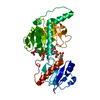

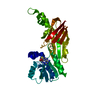
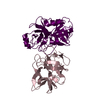
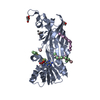
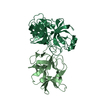
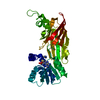
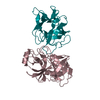
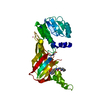
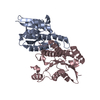
 PDBj
PDBj







